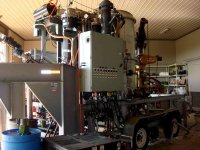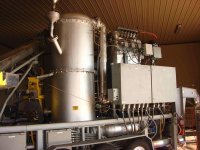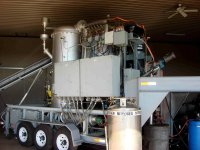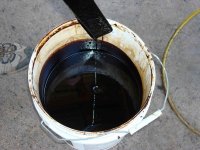Bullseye 2620
Member
We have all heard the expression, "as worthless as chicken ____."
Well folks, it turns out that chicken manure may not be so worthless after all.
My friend and former colleague at Virginia Tech, Professor Foster Agblevor, has developed a process that turns chicken manure into diesel fuel, either Number 4 (bunker oil) or Number 2 (equivalent to motor fuel or home heating oil).
Originally funded by the National Fish and Wildlife Foundation to demonstrate a way to prevent the leaching of excess phosphorus and nitrogen into the rivers and ultimately into the Chesapeake Bay, this system uses catalytic pyrolysis, where the chicken litter (manure plus bedding, usually wood chips) is heated to 450º C. in the absence of oxygen to form three components -- carbon ash, pyrolysis oil, and synthesis gas, or "syngas," which is carbon monoxide plus hydrogen. The carbon ash is useful as a soil amendment. The pyrolysis oil is the equivalent of No. 4 (bunker oil), and the syngas can be further transformed into what Foster calls "green diesel," which is not the same as biodiesel but can be used in similar applications (e.g., motor vehicle or heavy equipment fuel).
This is important for the large chicken industry here in the Shenandoah Valley of Virginia, and in other major chicken producing states like North Carolina, Arkansas, and Oklahoma, because of the water pollution problems that result when chicken litter is spread on fields. Chicken producers also confront the very expensive need to keep their chicken houses heated, which usually involves the use of large amounts of expensive propane. Now, Foster's process gives them a way to dispose of the large amounts of waste that their operations produce, and at the same time gives them an alternative fuel, at very little cost, with which to heat their chicken houses.
This project is at the demonstration stage, and a portable unit is now in operation in Dayton, Virginia, at the northern end of the Shenandoah Valley. Right now, the focus is on testing the system and making sure that it, and the No. 4 it produces, is economically useful to the chicken producers. The next step will be to attach a separate module to the system to transform the syngas into No. 2, for use in trucks, tractors, cars, and other heavy equipment that normally uses conventional petroleum diesel.
While the development of cellulosic ethanol (not made from corn kernels, but from corn stalks and other non-grain biomass) is proceeding slowly because of technical problems in breaking down the cellulose that composes plant fibers into fermentable sugars from which ethanol may be distilled, Foster's process has no such issues, and promises to come to market fairly soon.
He tells me that at commercial scale, this could drastically lower the cost of diesel fuel and home heating oil, to perhaps as low as $1.50 a gallon. And by the way, his studies show that his "chicken diesel" is more energy dense (more BTUs per gallon) than the currently available biodiesel made from soybean oil or waste grease from kitchen operations. It also reduces air pollution by 88% compared to what happens when you burn petroleum diesel and is 100% carbon neutral.
I have attached some photos of the pilot system, which is trailer mounted and thus portable, allowing it to be transported from farm to farm -- much easier than moving around tons and tons of chicken litter. The second to last photo shows the No. 4 as it comes out of the reactor, ready to use to heat the chicken houses. The last illustration which shows how the process works in schematic form.
What can I say? Virginia Tech -- Invent the Future!
Bullseye
P.S.: I want to thank Bruce Lee M for raising the question about the composition of this stuff with respect to the nitrates it contains (see below). If you don't burn the bio-oil, it can be further refined to make explosives, including gunpowder.
Well folks, it turns out that chicken manure may not be so worthless after all.
My friend and former colleague at Virginia Tech, Professor Foster Agblevor, has developed a process that turns chicken manure into diesel fuel, either Number 4 (bunker oil) or Number 2 (equivalent to motor fuel or home heating oil).
Originally funded by the National Fish and Wildlife Foundation to demonstrate a way to prevent the leaching of excess phosphorus and nitrogen into the rivers and ultimately into the Chesapeake Bay, this system uses catalytic pyrolysis, where the chicken litter (manure plus bedding, usually wood chips) is heated to 450º C. in the absence of oxygen to form three components -- carbon ash, pyrolysis oil, and synthesis gas, or "syngas," which is carbon monoxide plus hydrogen. The carbon ash is useful as a soil amendment. The pyrolysis oil is the equivalent of No. 4 (bunker oil), and the syngas can be further transformed into what Foster calls "green diesel," which is not the same as biodiesel but can be used in similar applications (e.g., motor vehicle or heavy equipment fuel).
This is important for the large chicken industry here in the Shenandoah Valley of Virginia, and in other major chicken producing states like North Carolina, Arkansas, and Oklahoma, because of the water pollution problems that result when chicken litter is spread on fields. Chicken producers also confront the very expensive need to keep their chicken houses heated, which usually involves the use of large amounts of expensive propane. Now, Foster's process gives them a way to dispose of the large amounts of waste that their operations produce, and at the same time gives them an alternative fuel, at very little cost, with which to heat their chicken houses.
This project is at the demonstration stage, and a portable unit is now in operation in Dayton, Virginia, at the northern end of the Shenandoah Valley. Right now, the focus is on testing the system and making sure that it, and the No. 4 it produces, is economically useful to the chicken producers. The next step will be to attach a separate module to the system to transform the syngas into No. 2, for use in trucks, tractors, cars, and other heavy equipment that normally uses conventional petroleum diesel.
While the development of cellulosic ethanol (not made from corn kernels, but from corn stalks and other non-grain biomass) is proceeding slowly because of technical problems in breaking down the cellulose that composes plant fibers into fermentable sugars from which ethanol may be distilled, Foster's process has no such issues, and promises to come to market fairly soon.
He tells me that at commercial scale, this could drastically lower the cost of diesel fuel and home heating oil, to perhaps as low as $1.50 a gallon. And by the way, his studies show that his "chicken diesel" is more energy dense (more BTUs per gallon) than the currently available biodiesel made from soybean oil or waste grease from kitchen operations. It also reduces air pollution by 88% compared to what happens when you burn petroleum diesel and is 100% carbon neutral.
I have attached some photos of the pilot system, which is trailer mounted and thus portable, allowing it to be transported from farm to farm -- much easier than moving around tons and tons of chicken litter. The second to last photo shows the No. 4 as it comes out of the reactor, ready to use to heat the chicken houses. The last illustration which shows how the process works in schematic form.
What can I say? Virginia Tech -- Invent the Future!
Bullseye
P.S.: I want to thank Bruce Lee M for raising the question about the composition of this stuff with respect to the nitrates it contains (see below). If you don't burn the bio-oil, it can be further refined to make explosives, including gunpowder.
Attachments
Last edited:





